Security
Overview
FormKiQ is designed with a robust security framework to safeguard access to documents, prioritizing protection measures at every layer of its architecture. FormKiQ supports advanced access control mechanisms using Role-Based Access Control (RBAC) with Amazon Cognito Groups and Attribute-Based Access Control (ABAC) through Open Policy Agent (OPA). These features ensure users have appropriate access to documents based on their roles and specific attributes.
By default the AdminEmail configured during the installation process is setup as an administrator with full access
Data Security
FormKiQ implements comprehensive security through encryption, access controls, and authentication:
Encryption in Transit
All data transmissions are encrypted using:
- TLS 1.2 or higher
- HTTPS-only endpoints
- API Gateway managed certificates
Encryption at Rest
FormKiQ Essentials, Advanced, and Enterprise offerings use AWS-managed encryption services for:
- Document Storage (S3)
- Metadata Storage (DynamoDB)
- Search Index (OpenSearch, part of the Enhanced Full-Text Search Add-On Module)
API Security
There are 3 APIs deployed with FormKiQ providing authorization using:
- JWT Tokens
- AWS IAM Authorization
- API Key Authorization
JWT Token
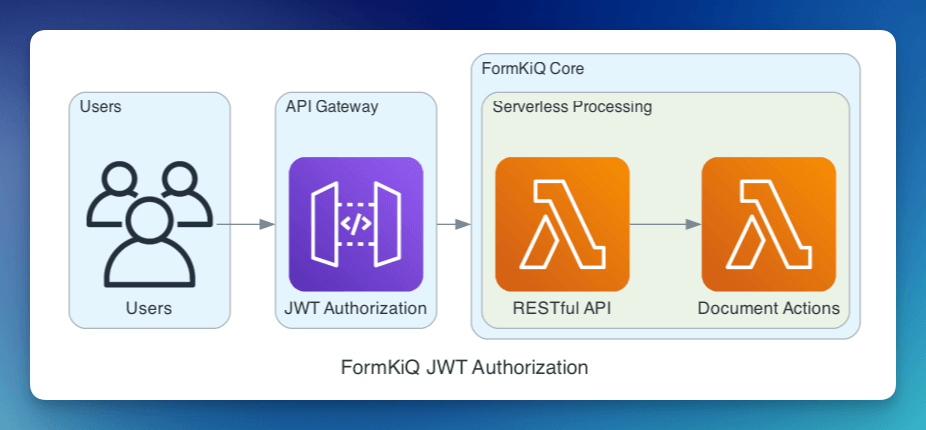
A JWT Token can be obtained via a few different methods:
FormKiQ Console
Access your JWT token using your browser developer tools:

Google Chrome
- Log in to FormKiQ Web Console
- Open Developer Tools (
F12orCtrl+Shift+I/Cmd+Option+I) - Select Network tab
- Refresh page
- Find request with token in Authorization header
- Copy token using Copy as cURL
Safari
- Log in to FormKiQ Web Console
- Enable Develop menu:
- Safari > Preferences > Advanced
- Check Show Develop menu
- Open Web Inspector (
Cmd+Option+I) - Select Network tab
- Refresh page
- Locate and copy token from request headers
Mozilla Firefox
- Log in to FormKiQ Web Console
- Open Developer Tools (
Ctrl+Shift+IorCmd+Option+I) - Select Network tab
- Refresh page
- Find request with token
- Copy using Copy Request Headers
Curl CLI
The Cognito API Endpoint can be found in the FormKiQ CloudFormation Outputs.
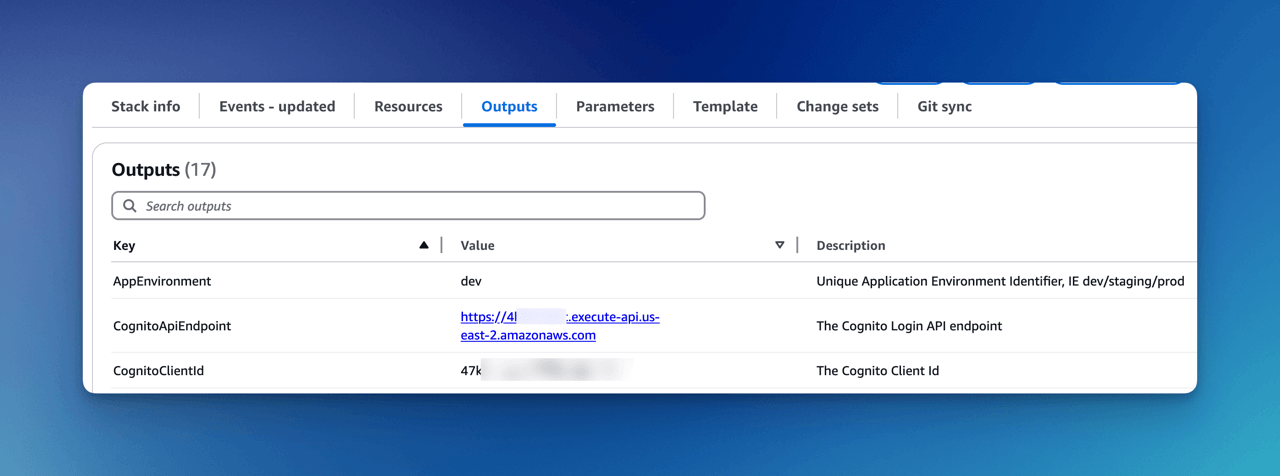
Using the API Endpoint you can obtain a JWT Token via:
curl -X POST https://COGNITO_API_ENDPOINT_URL/login \
-H "Content-Type: application/json" \
-d '{"username": "USERNAME", "password": "PASSWORD"}'
AWS CLI
The Cognito CognitoClientId can be found in the FormKiQ CloudFormation Outputs.

Using the CognitoClientId, you can obtain a JWT Token via:
aws cognito-idp initiate-auth \
--client-id YOUR_COGNITO_APP_CLIENT_ID \
--auth-flow USER_PASSWORD_AUTH \
--auth-parameters USERNAME=your_username,PASSWORD=your_password
The results from the command should be as follows.
{
"ChallengeParameters": {},
"AuthenticationResult": {
"AccessToken": "eyJraWQiOiJ0W...",
"ExpiresIn": 86400,
"TokenType": "Bearer",
"RefreshToken": "eyJjdHkiO...",
"IdToken": "eyJraWQiOiI5YUpvb..."
}
}
AWS IAM
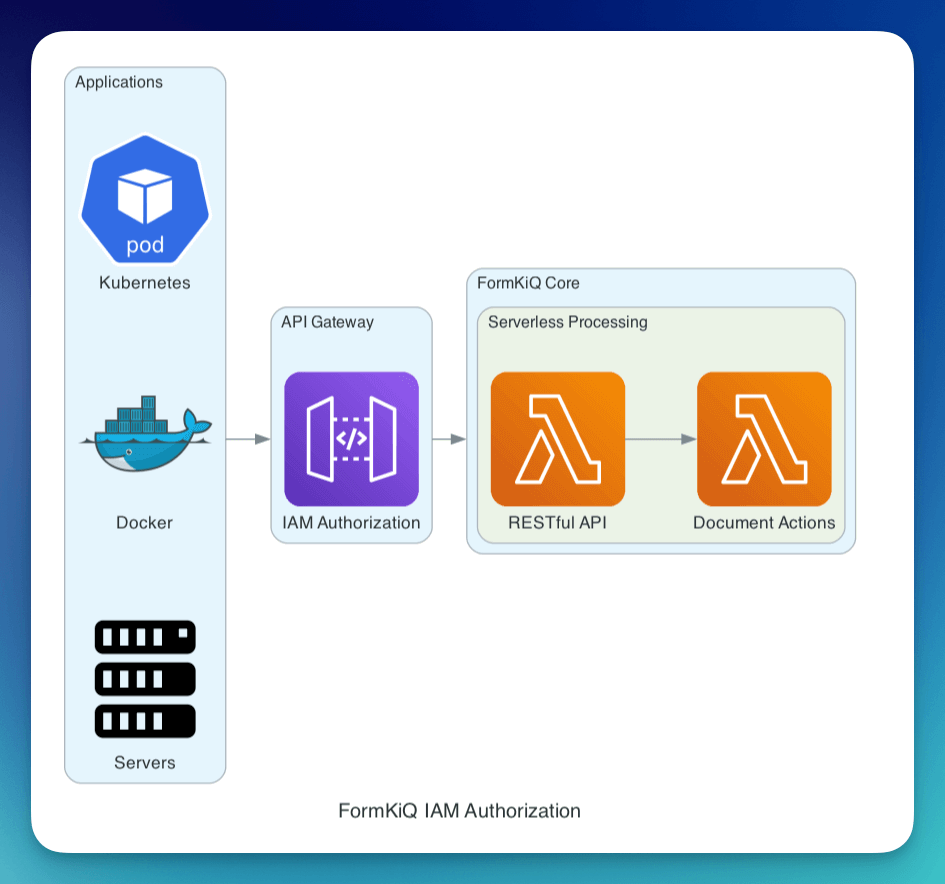
Endpoints secured with IAM require that your API requests be signed using AWS Signature Version 4. This method leverages using AWS credentials.
More information on how IAM Authentication fits into Cloud Security best practices
Setting Up IAM Authorization
From AWS IAM Console, create a new user.

Attach AmazonAPIGatewayInvokeFullAccess policy to user.
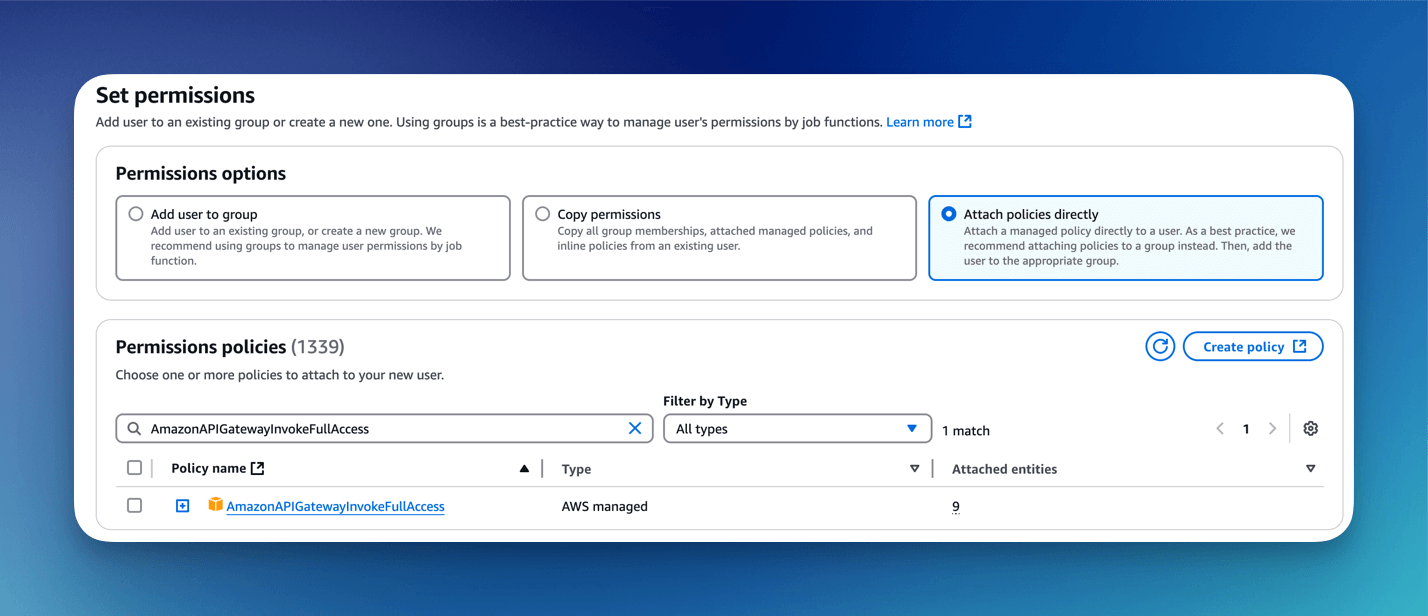
Create user Access Key and generate AccessKey/SecretKey.

You an now use the AccessKey / SecretKey to call the FormKiQ API.
API Key
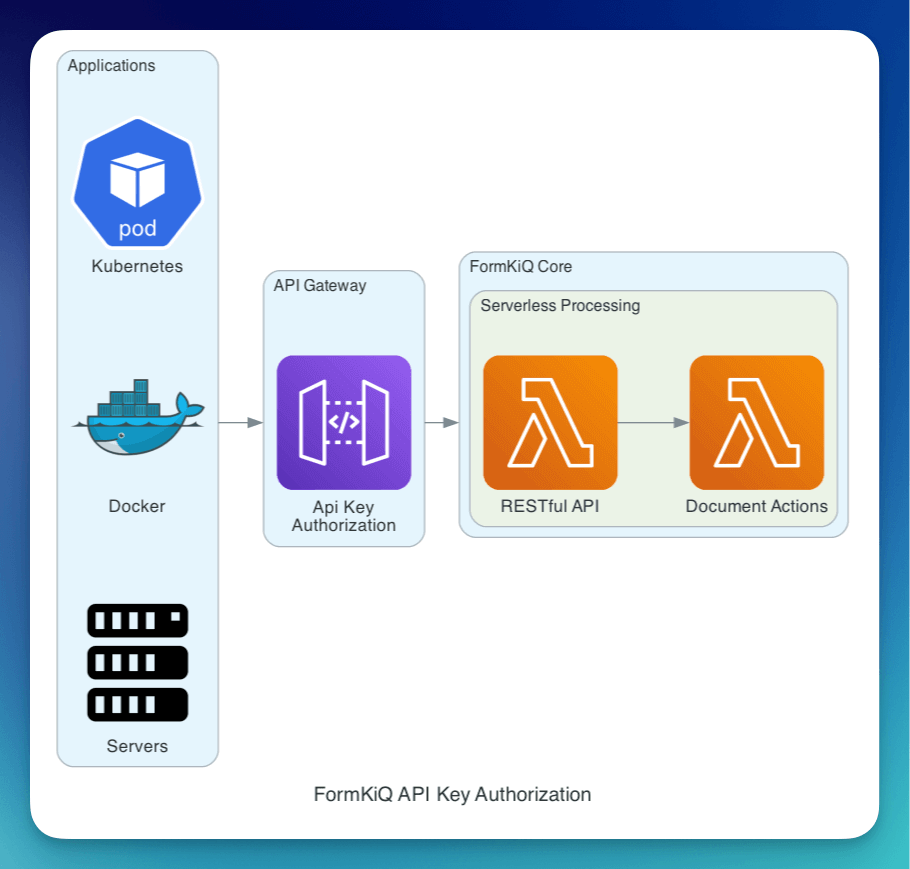
- Log in to FormKiQ Console
- Navigate to Administration > API Keys
- Click Create new
- Set name and permissions
- Copy generated key immediately

API Endpoints
The FormKiQ API is built on top of AWS API Gateway. API Gateway offers the flexibility to empowers customers to choose the most suitable authentication and authorization methods based on their specific application requirements.
By default FormKiQ API supports 3 different types of authorization:
-
JSON Web Token(JWT) Authorizers
-
Amazon Identity and Access Management (IAM) authorization
-
API Key authorization

FormKiQ supports these different authorization mechanisms by deplying multiple copies of the API. This allows you to use the authentication mechanism that suits your needs.
The FormKiQ API URL(s) can be found in the CloudFormation outputs of your FormKiQ stack.

FormKiQ Enterprise users have additional authentication options like Security Assertion Markup Language (SAML) or custom authentication mechanisms
JSON Web Token(JWT) Authorizers
JWT authentication, also known as JSON Web Token authentication, is a method used to verify the identity of users or systems accessing web applications or APIs. It is based on the use of digitally signed tokens containing encoded claims about the user's identity and permissions.
By default, FormKiQ uses Amazon Cognito as the JWT Issuer and authorization is handled through role-based access control assigned to each user.
The API that uses the JWT authentication can be found in the CloudFormation Outputs of the FormKiQ installation under the HttpApiUrl key.

Amazon Identity and Access Management (IAM) authorization
IAM Authentication allows customers to call the FormKiQ API by signing requests using Signature Version 4 with AWS credentials.
IAM Authentication is typically used for machine-to-machine authorization as there is no user information inside of the token.
More information on how IAM Authentication fits into Cloud Security best practices
The API that uses the IAM authentication can be found in the CloudFormation Outputs of the FormKiQ installation under the IamApiUrl key.

You need the IAM execute-api permission to be able to use IAM Authentication and all requests will be run with administration privileges.
For more information on creating this IAM User, please see the instructions in our API Walkthrough.
API Key
FormKiQ allows for the generating of an API key that can be used to access the FormKiQ API for a particular SiteId.
The API key can be generated using the POST /configuration/apiKeys API endpoint using credentials with administrator privileges.
The API that uses the Key authentication can be found in the CloudFormation Outputs of the FormKiQ installation under the KeyApiUrl key.

Each API key is only valid for a particular SiteId.
Role-Based Access Control (RBAC)
FormKiQ supports true multi-tenant environments by grouping users according to their roles and mapping those groups to one or more sites.
Each user can be associated with one or more groups, reflecting their role or responsibilities within the platform. These groups, in turn, determine the user's access privileges across different sites within the platform.
You can choose between:
-
Automatic Site Permissions — sites and permissions are inferred from group names.
-
Defined Site Permissions — sites are created explicitly, and permissions are granted via API (only supported in FormKiQ Essentials / Enterprise).
Automatic Site Permissions
When you use Automatic mode, any group whose name matches the pattern above will automatically create (or link to) a site of the same name, granting the corresponding permissions.
FormKiQ sites are created automatically when a user interact with the API.
| Group | Access Level |
|---|---|
Admins | Full Administrator rights on all sites |
authentication_only | Can log in, but no site access |
<site> | Read/Write/Delete on <site> |
<site>_read | Read only on <site> |
<site>_govern | Read/Write/Delete + Govern on <site> |
Example:
Finance⇒ Read/Write/Delete on financeFinance_read⇒ Read only on financeFinance_govern⇒ Read/Write/Delete + Govern on finance
If a user belongs to multiple groups, their permissions combine.
Example user: member of Managers and Finance_read
Managers⇒ Read/Write/Delete on managersFinance_read⇒ Read on finance- Result: Read/Write/Delete on managers, Read on finance
Govern access provides additional permissions to allow data governance or document control role access
Default Cognito Groups
By default FormKiQ uses Amazon Cognito for user authentication and comes with the following default groups.
| Default Group | Permissions |
|---|---|
Admins | Full admin privileges across all sites |
authentication_only | Can authenticate, but no site access |
default | Read/Write/Delete on the default site |
default_read | Read only on the default site |

The Cognito User pool can be found by visiting the Cognito Console page and searching for the AppEnvironment name you configured during installation.

Add Multi-Tenant Site
Creating a new Multi-Tenant Site is as easy as creating a new group and adding users to the group.
To add a new group:
- Open the FormKiQ Console as an Administrator
- Click on the Groups menu option under the Administration left menu
- Click Create New Group and enter the name of the group
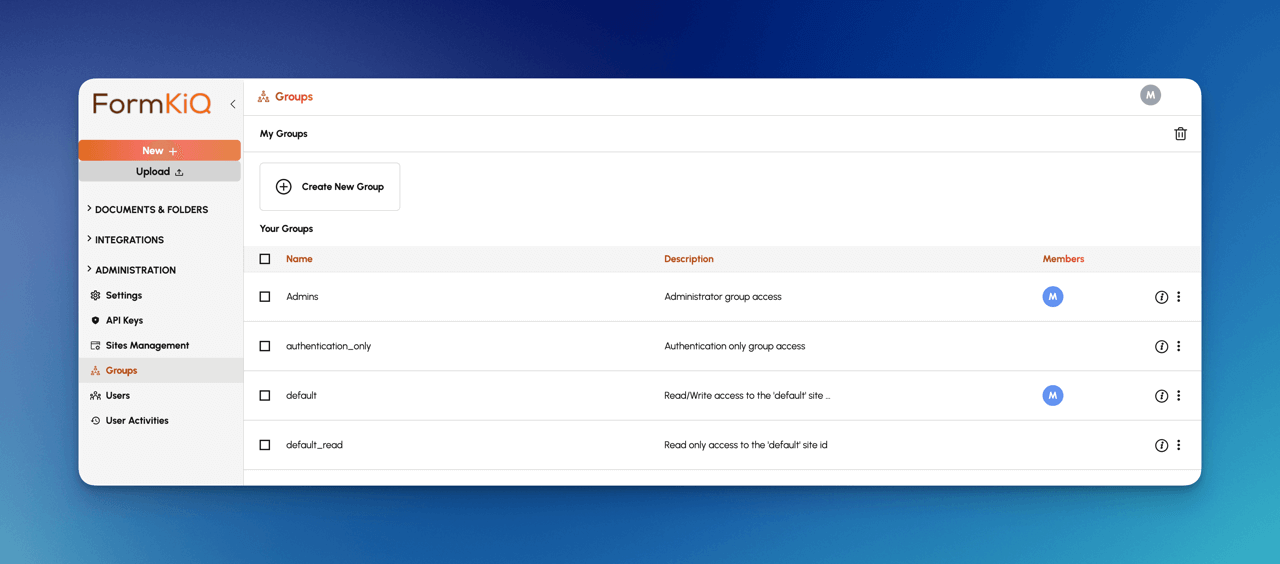
The site has now been created and you can add users to this group to give them access to the finance site.
Add User to Site
To add a new user:
- Open the FormKiQ Console as an Administrator
- Click on the Users menu option under the Administration left menu
- Click Create New User and enter the name of the user
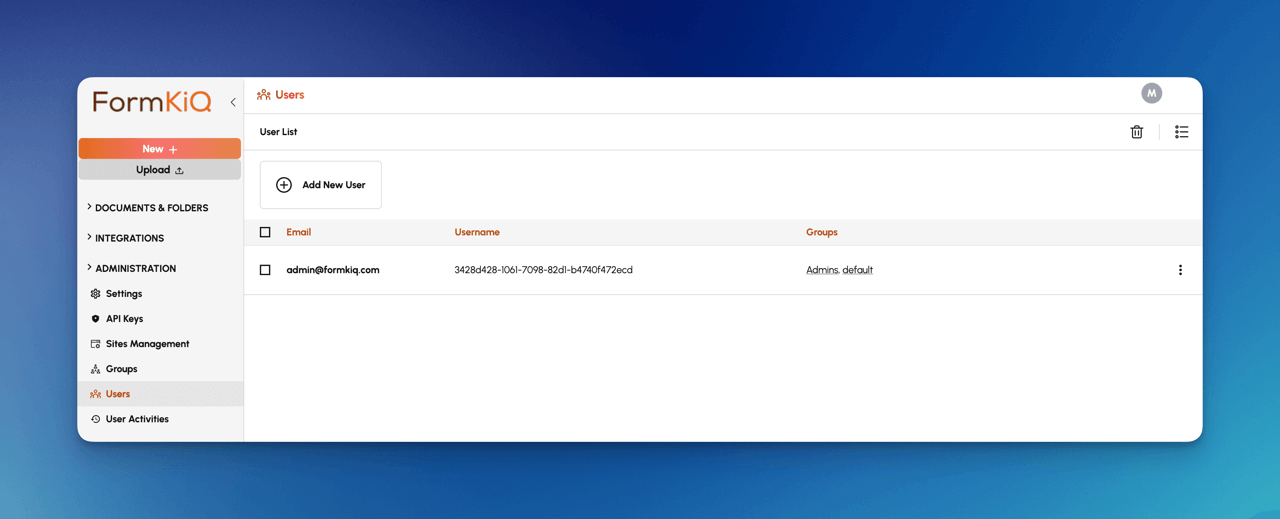
Add User to Group
To add a user to a group:
- Open the FormKiQ Console as an Administrator
- Click on the Groups menu option under the Administration left menu
- Click the far right menu on the Group you want to add the user to and click Add Member

You can search for the user and add it to the group.
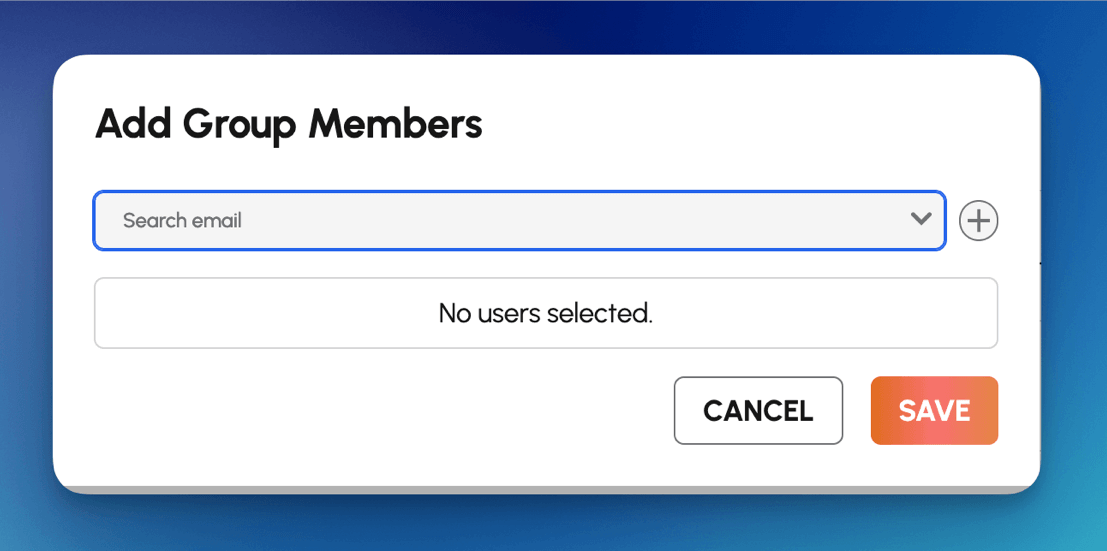
Defined Site Permissions
Defined site permission requires the explicit creation of FormKiQ Sites and then user groups can be links to a site with specific permissions.
Add Site
A defined site can ONLY be created by a user with administrator access.
The example below will create a FormKiQ Site called projects.
POST /sites
{
"site": {
"id": "projects",
"title": "A site that contains system projects",
"status": "ACTIVE"
}
}
Add Group Permissions
The PUT /sites/:siteId/groups/:groupName/permissions API can be used to give a group particular permission for a site.
For example:
If you have a group called employees and you want to give members of that group READ / WRITE access to the projects FormKiQ site, use the API
PUT /sites/projects/groups/employees/permissions
{
"permissions": [
"READ", "WRITE"
]
}
Folders Permissions
Beyond site-wide roles, you can lock down or share specific folders by assigning folder-scoped RBAC directly via the API. Folder permissions work in addition to site-level RBAC: a user must have both the site-level permission and the folder-level permission to perform an action.
Permission Types
When setting folder ACLs, you may assign any combination of:
- READ — List or download documents in this folder
- WRITE — Create or update documents in this folder
- DELETE — Remove documents from this folder
- GOVERN — Perform governance actions (audit logs, retention holds)
API Endpoint
Sets a folders role permissions.
PUT /folders/permissions
Request Body Parameters
| Field | Type | Description |
|---|---|---|
| path | string | Folder path within the site |
| roles | array | List of role/permission mappings to apply |
| roleName | string | string Cognito group or custom role to grant folder permissions |
| permissions | string[] | One or more of ["READ","WRITE","DELETE","GOVERN"] |
Example Request Body
{
"path": "invoices/2025/Q2",
"roles": [
{
"roleName": "Finance",
"permissions": ["READ", "WRITE", "DELETE"]
},
{
"roleName": "Managers",
"permissions": ["READ"]
}
]
}
Attribute-Based Access Control (ABAC)
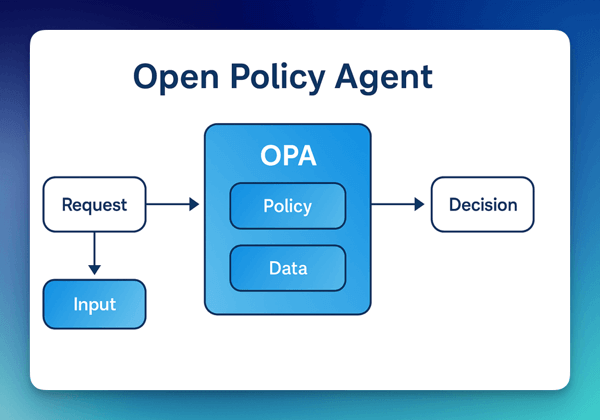
Attribute-Based Access Control (ABAC) is a dynamic and flexible method of managing access permissions based on the evaluation of attributes related to the user, the resource, and the environment. Unlike Role-Based Access Control (RBAC), which assigns permissions based on predefined roles, ABAC uses policies that evaluate various attributes to determine access rights.
FormKiQ's ABAC is implemented using Open Policy Agent (OPA). OPA is an open-source, general-purpose policy engine that allows for fine-grained access control based on user attributes and other contextual information. ABAC enables dynamic and context-aware access control policies.
OPA Evaluation Policies
Open Policy Agent (OPA) evaluates the policies and returns decisions based on the evaluation. The evaluation outcomes in OPA are allow, deny, and partial.
Allow
The allow policy in OPA explicitly grants access to a document. This decision is made when the conditions specified in the policy are met. For example, a policy might allow access if a user has the appropriate role or attribute, or if the request is made during certain hours.
package example
default allow = false
allow {
input.user.role == "admin"
}
Deny
The deny policy in OPA explicitly denies access to a resource. This decision is made when the conditions specified in the policy are met. Deny policies can be used to enforce restrictions that override any allow policies.
package example
default deny = false
deny {
"guest" in input.user.roles
}
deny {
"guest" in input.user.roles
data.documents.documentType == "private"
}
Partial
OPA's partial evaluation feature allows for the computation of policy decisions based on the attributes attached to a document or resource. Partial evaluation generates a list of criteria that need to be met to gain access to the document or resource.
The OPA policy below restricts access to users in the "guest" role to documents whose documentType attribute is "public".
package example
default allow = false
allow {
"guest" in input.user.roles
data.documents.documentType == "public"
}
Partial Limitations
Due to OPA's partial evaluation flexibility there are some limitation to be aware of.
When using searching for documents using POST /search, if you are using multiple attributes criteria you will need to have an attribute composite key configured to enable DynamoDb to search for the criteria. Alternatively using POST /searchFulltext uses OpenSearch and does not have such limitation.
Attribute-Based Access Control (ABAC) is only supported when using FormKiQ Advanced/Enterprise.
Document Attributes
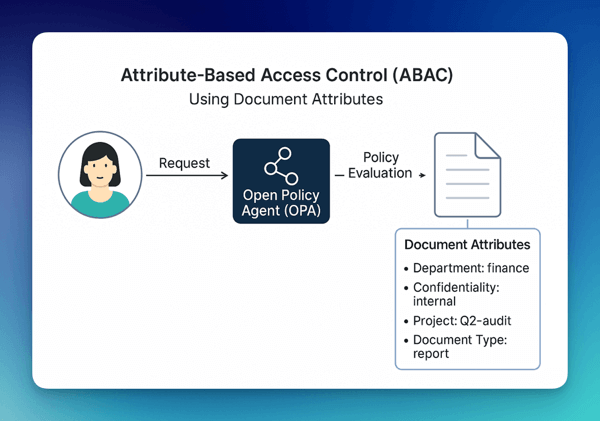
FormKiQ enables Attribute-Based Access Control (ABAC) by attaching metadata — called Document Attributes — to individual documents. These attributes can then be evaluated by Open Policy Agent (OPA) policies to determine whether a user is allowed to access, modify, or delete a document.
Each document in FormKiQ may have one or more attributes associated with it, such as:
departmentconfidentialityownerprojectdocumentTypeclassification
These attributes form the resource context used in OPA's decision-making process. When a user makes a request, the OPA policy can evaluate both the user attributes (such as roles, department, or clearance level) and the document attributes to make a dynamic access decision.
API Endpoint
This endpoint allows administrators to define or update OPA access policies for a specific site. These policies use attribute-based access control (ABAC) logic to determine document access based on user roles and document attributes.
PUT /sites/:siteId/opa/accessPolicy/policyItems
Request Body Parameters
| Field | Type | Description |
|---|---|---|
| type | string | Type of policy logic. Only "ALLOW" is currently supported. |
| allRoles | string[] | The user must belong to all listed roles to match the policy. |
| anyRoles | string[] | The user must belong to at least one listed role to match the policy. |
| attributes | array | A list of attribute matchers used to evaluate access. |
Each attribute object supports multiple conditional operators:
| Operator | Description |
|---|---|
| eq | Equal to (string, number, boolean, or username match) |
| neq | Not equal to |
| gt | Greater than (number only) |
| gte | Greater than or equal to |
| lt | Less than |
| lte | Less than or equal to |
Special value for eq.input.matchUsername:
- When true, the document attribute must equal the authenticated user’s username.
Example Use Cases
Restrict Access to Reports Only
Allow users with the finance and auditor roles to access documents where documentType = report.
{
"type": "ALLOW",
"allRoles": ["finance", "auditor"],
"attributes": [
{
"key": "documentType",
"eq": {
"stringValue": "report"
}
}
]
}
Owner-Only Access
Allow users to access documents only if they are the owner (based on the username in the access token).
{
"type": "ALLOW",
"anyRoles": ["user"],
"attributes": [
{
"key": "owner",
"eq": {
"input": {
"matchUsername": true
}
}
}
]
}
Cloud Security
In addition to FormKiQ's Well-Architected Framework, other security and compliance considerations should be reviewed:
DynamoDB Point-in-Time Recovery
FormKiQ automatically configures Point-in-Time Recovery for all DynamoDB tables (except cache tables) with a 35-day recovery window. This automated backup feature ensures that your document data is protected against accidental deletions, application errors, or service disruptions.
Why DynamoDB Backups Matter in Production
Automated backups for your DynamoDB tables provide essential data protection for your FormKiQ deployment:
- Data Recovery: Quickly restore to any point within the last 35 days in case of accidental deletion or corruption
- Business Continuity: Minimize downtime and data loss in the event of application errors or service disruptions
- Compliance Requirements: Meet regulatory requirements for data retention and disaster recovery capabilities
- Operational Peace of Mind: Operate with confidence knowing that your document database is continuously backed up
FormKiQ's implementation of Point-in-Time Recovery requires no additional configuration from customers while providing enterprise-grade data protection for your document management system.
IAM Authentication Option
FormKiQ supports IAM Authentication for API access, providing an enhanced security option for environments where additional access controls are required.
Why IAM Authentication Matters in Production
Using IAM Authentication for your FormKiQ API access establishes strong identity-based security:
- Fine-grained Access Control: Leverage AWS IAM policies to define precise permissions for API operations
- Credential Management: Eliminate the need to manage separate API keys by using your existing AWS identity system
- Audit Trail: Benefit from detailed CloudTrail logs of all authenticated API requests
- Conditional Access: Apply additional security conditions such as source IP restrictions or MFA requirements
- Integration with Identity Federation: Seamlessly connect with your organization's identity provider
By enabling IAM Authentication for your FormKiQ deployment, you can implement defense-in-depth security strategies while maintaining compatibility with your existing AWS security practices.
AWS DNS Firewall
AWS DNS Firewall can be implemented by FormKiQ customers to filter and control outbound DNS traffic from their VPC. Once configured, these DNS firewall settings will not be modified by any FormKiQ updates.
Why AWS DNS Firewall Matters in Production
AWS DNS Firewall provides an essential layer of protection for your FormKiQ deployment by controlling DNS resolution and preventing DNS-based threats. In production environments, this service offers several important security benefits:
- Malware Prevention: Block DNS queries to known malicious domains, helping prevent malware downloads and command-and-control communications
- Data Exfiltration Protection: Prevent unauthorized data transfers that use DNS tunneling techniques to bypass standard security controls
- Domain Filtering: Implement allow/deny lists to ensure your FormKiQ resources only communicate with approved domains
- Compliance Assurance: Meet regulatory requirements for network security controls and demonstrate proactive threat prevention
- Security Monitoring: Generate logs of DNS activity for security analysis and threat detection
By implementing AWS DNS Firewall with your FormKiQ deployment, you establish preventative controls against DNS-based threats while maintaining visibility into DNS query patterns that might indicate security issues.
FormKiQ respects your DNS security configurations and operates within the boundaries established by your DNS Firewall rules, providing an additional layer of security for your document management system.
Password Policy
FormKiQ allows customization of the password policy for each FormKiQ instance using the CloudFormation template.
Why Strong Passwords Matter in Production
In production environments, strong passwords are your first line of defense against unauthorized access. Production systems typically contain sensitive data, customer information, and business-critical functionality that must be protected. A robust password policy helps safeguard against various attack vectors:
- Brute force attacks where attackers systematically attempt every possible password combination
- Dictionary attacks that try common words and phrases
- Credential stuffing attacks using passwords leaked from other breaches
By implementing strong password requirements (length, complexity, rotation periods), you significantly reduce the risk of security breaches that could lead to data loss, service disruption, or compliance violations. For regulated industries, strong password policies are often a compliance requirement.
Your FormKiQ password policy should align with your organization's security posture and industry best practices while balancing security with usability.
VPC Flow Logs
VPC Flow Logs can be set up by FormKiQ customers to monitor network traffic within their Virtual Private Cloud environment. Once associated with the VPC, these logs will not be modified by any FormKiQ updates.
Why VPC Flow Logs Matter in Production
VPC Flow Logs provide valuable network traffic visibility for your FormKiQ deployment, capturing information about IP traffic going to and from network interfaces in your VPC. In production environments, these logs serve multiple critical functions:
- Security Monitoring: Detect suspicious traffic patterns or potential network intrusions by analyzing traffic flows to and from your FormKiQ resources
- Troubleshooting: Diagnose connectivity issues between components or with external services by identifying blocked or failed connection attempts
- Compliance Requirements: Meet regulatory requirements for network traffic monitoring and data access auditing
- Operational Insights: Gain visibility into traffic patterns to optimize network configurations and resource allocation
By implementing VPC Flow Logs for your FormKiQ deployment, you create a continuous audit trail of network activity that can be integrated with security information and event management (SIEM) systems or analyzed directly for security and operational insights.
FormKiQ operates within your configured VPC environment, respecting your network security controls and logging configurations without interference.